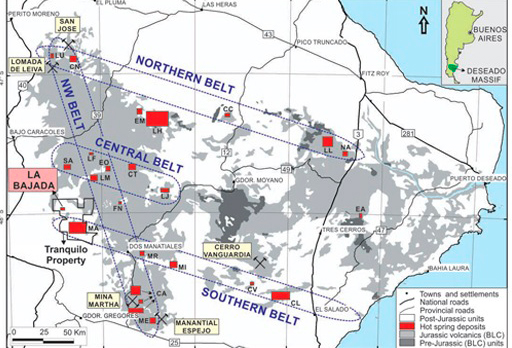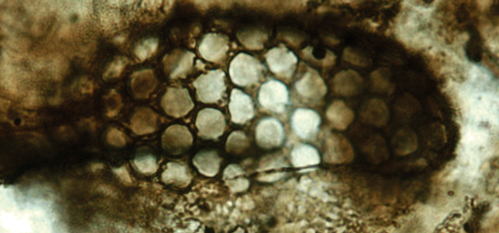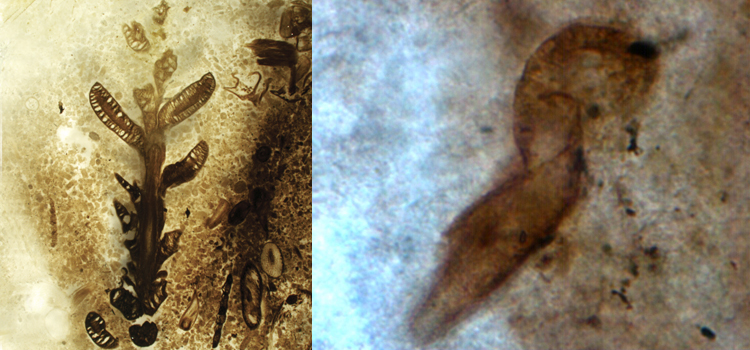Major Jurassic and Early Cretaceous Fossil Site Announced
A team of scientists have announced the discovery of an enormous area of fossil-rich land in the highlands of southern Patagonia (Argentina), the site, which has yet to be fully explored, may extend for some sixty thousand square kilometres and as such, this location may prove to be the greatest single concentration of fossils (Lagerstätten) yet found anywhere in the world. Lead author of the research paper published in the on line, bi-monthly, scientific journal “Ameghiniana”, Juan Garcia Massini, concludes that this huge site could provide an unprecedented amount of fossil material and provide an unparalleled view of life on Earth between 160 million and 140 million years ago.
Fossil Site
The discovery was made back in 2012, but it has taken nearly four years for the Argentinian research team to map and plot the area and to gain an appreciation of the astonishing array of organisms preserved.
A Map of the Southern Highlands of Patagonia Showing the Hot Spring Fossil Locations
Picture credit: Regional Centre for Scientific Research and Technology Transfer
For Juan Garcia Massini (Regional Centre for Scientific Research and Technology Transfer, known s CRILAR), the site is truly remarkable, he stated:
“No other place in the world contains the same amount of diversity of Jurassic fossils.”
Volcanic Hot Springs Preserve Fossils in Exquisite Detail
This region of southern Argentina was once very geologically active. There were volcanoes and hot springs, resembling the sort of springs found in Yosemite National Park (in the Sierra Nevada mountains of California), from time to time these hot springs went into overdrive and large amounts of silica-rich, hot water erupted, covering the land. This petrified the local fauna and flora that was not mobile enough to get out of the way. The organisms were preserved in situ and almost instantaneously trapped as fossils. This led to an amazing degree of preservation. Plant remains, fungi, nematodes, insects and other Arthropods have been preserved, providing scientists with a unique window into life in the Late Jurassic and Early Cretaceous.
Dr Massini explained:
“You can see the landscape as it appeared in the Jurassic—how thermal waters, lakes and streams as well as plants and other parts of the ecosystem were distributed.”
The Fossilised Compound Eye of an Insect
Picture credit: Regional Centre for Scientific Research and Technology Transfer
The exquisite fossilised eye was found in an area of the Patagonian Highlands called La Bajada, just one of several areas identified so far to have particularly high concentrations of fossils. By slicing the silicate rocks and polishing the exposed surface, very small fossils of the micro fauna and flora can be observed.
The area has been slowly eroded exposing the highly fossiliferous layers, providing the scientists with an almost pristine “in situ” Jurassic and Early Cretaceous landscape to study.
A Piece from a Conifer and a Nematode Worm
Picture credit: Regional Centre for Scientific Research and Technology Transfer
A Large Number of Specimens from the Fossil Site
A large number of fossils are remarkably well preserved, the speed of petrification may have caused this, with the scientists suggesting that significant areas may have been covered by the hot springs in less than a day, preserving the area as a time capsule providing a unique window into life in the Mesozoic.
Dr Massini added:
“You can see how fungi, cyanobacteria and worms moved when they were alive.”
The slow erosion of the layers of rock that covered the sites in the Deseado Massif mountain range has contributed to the phenomenal level of preservation. The region has been compared to the famous Rhynie Chert sedimentary deposits of eastern Scotland, named after the nearby village of Rhynie (Aberdeenshire). This site preserves the flora and fauna of a Devonian ecosystem that was also preserved due to the influx of hot springs inundated with silica. These fossils are much older, dating from approximately 410 million years ago (Pragian faunal stage of the Early Devonian). The Rhynie Lagerstätten preserves evidence of some of the very first terrestrial inhabitants, including the first land plants.
The silica-rich sediments are referred to as cherts and when sliced very thinly and studied under powerful microscopes they reveal their fossil content. The preparation, cutting and polishing of the material will take time, the field team expect to be working on the Deseado Massif for decades as they gradually build up an extremely detailed and unique picture of life in the Mesozoic.









Leave A Comment